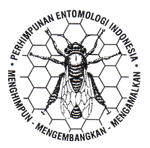Variasi perilaku mencari makan pada semut rangrang Oecophylla smaragdina (Fabricius) pada habitat yang berbeda
Variations of foraging behavior of weaver ants Oecophylla smaragdina (Fabricius) in different habitats
DOI:
https://doi.org/10.5994/jei.20.2.141Keywords:
competition, non-urban, Oecophylla smaragdina, sequencial of foraging behavior, urbanAbstract
Weaver ants (Oecophylla smaragdina (Fabricus)) are carnivorous insects and play a role as biocontrol agents in urban habitats. This study aims to analyze the foraging behavior of O. smaragdina in two different habitats, namely urban and non-urban. The two locations are characterized by differences in the intensity of human interaction and the distance between the trees and the tree canopy. The behavioral observation method uses all sampling events with five behavioral categories: lurking (M1), approaching (M2), carrying (M3), communicating between ants in a colony (K1), and competition with other ants (K2). We tested three different types of feed: chick scraps, Tenebrio molitor Linnaeus larvae, and sugar. The results showed that there were three sequences of foraging behavior in urban areas, namely: (1) M1, M2, K1, M3, (2) M1, M2, K1, M3, K2, and (3) M1, M2, K2, M3. Meanwhile, there is only one pattern in non-urban areas, namely M1, M2, M3. Approaching food (M2) and lurking food (M1) were the dominant responses of O. smaragdina in urban and non-urban areas. In urban areas, broiler chickens were the type of feed most approached by ants, followed by sugar and beetle larvae. O. smaragdina in non-urban areas also preferred chicken pieces as feed compared to the others, but only one individual O. smaragdina approached (M2) chicken pieces and none approached the others. Foraging ants are more active at high temperature and low humidity, compared to low temperature and high humidity. Therefore, the foraging behavior of O. smaragdina is influenced by habitat factors.
Downloads
References
Agosti D, Major DJ, Alonso LE, Schultz TR. 2000. Ants: Standard Methods for Measuring and Monitoring Biodiversity. Washington: Smithsonian Institution Press.
Cammaerts MC. 2013. Trail following learning by young Myrmica rubra workers (Hymenoptera, Formicidae). ISRN Entomology. 2013:1−6. DOI: https://doi.org/10.1155/2013/792891.
Cammaerts MC, Cammaerts R. 2016. Ants can expect the time of an event on basis of previous experiences. ISRN Entomology. 2016:1−9. DOI: https://doi.org/10.1155/2016/9473128.
Dianing RL, Basuki E, Darsono. 2017. Kuantiasanakan kultur semut rangrang, Oecophylla smaragdina, sacara arti fisial dengan menggunakan beberapa jenis pakan yang berbeda. Scripta Biologica. 4:47−51. DOI: https://doi.org/10.20884/1.sb.2017.4.1.385.
Devarajan, K. 2016. The antsy social network: Determinants of nest structure and arrangement in Asian weaver ants. Plos One. 11:e0156681. DOI: https://doi.org/10.1371/journal.pone.0156681.
Falahudin I. 2012. Peranan Semut Rangrang (Oecophylla smaragdina) dalam Pengendalian Biologis Pada Perkebunan Kelapa sawit. Palembang: Fakultas Tarbiyah IAIN Raden Fatah.
Hardiyanti, Yusminah H, Eka PT. 2015. Identifikasipola perilaku pada semut jepang dewasa. Bionature. 16:63−68.
Hirt MR, Lauermann T, Brose U, Noldus LPJJ, Dell AI. 2017. The little things that run: A general scaling of invertebrate exploratory speed with body mass. Ecology. 98:2751–2757. DOI: https://doi.org/10.1002/ecy.2006.
Holldobler B. 1983. Territorial behavior in the green tree ant (Oecophylla smaragdina). Biotropica. 15:241−250. DOI: https://doi.org/10.2307/2387648.
Howard DF, Tschinkel WR. 1980. The effect of colony size and starvation on food flow in the fire ant, Solenopsis invicta (Hymenoptera: Formicidae). Behavioral Ecology and Sociobiology. 7:293−300. DOI: https://doi.org/10.1007/BF00300670.
Louise VO, Elise B, Raphaël B, Carlos B, Xim Cerdá. 2011. Temperature limits trail following behaviour through pheromone decay in ants. Nature Wissen Schaften. 98:1009−1017. DOI: https://doi.org/10.1007/s00114-011-0852-6.
Maschwitz U, Hanel H. 1985. The migrating hersman Dolichoderus (diobolus) cuspidatus an ant with a novel mode of life. Behavioral Ecology and Sociobiology. 17:171−184. DOI: https://doi.org/10.1007/BF00299249.
Offenberg J, Thu CNT, Decha W.2013. The effectivess of weaver ant Oecophylla smaragdina biocontrol in southestasean citrus and mango. Asian Myrmecology. 3:139−149.
Oudenhove. VL, Billoir E, Boulay R, Bernstein C, Cerdá X. 2011. Temperature limits trail following behavior through pheromone decay in ants. Naturwissenschaften. 98:1009–1017. DOI: https://doi.org/10.1007/s00114-011-0852-6.
Pimid M, Ahmad AH, Krishnan KT, Scian J. 2019. Food preferences and foraging activity of asian weaver ants, Oecophylla smaragdina (Fabricius) (Hymenoptera: Formicidae). Tropical Life Sciences Research. 30:167–179. DOI: https://doi.org/10.21315/tlsr2019.30.2.12.
Porter SD, Tschinkel WR. 1987. Foraging in Solenopsisinvicta (Hymenotpera: Formicidae): effects of waether and season. Environmental Entomology. 16:802−808. DOI: https://doi.org/10.1093/ee/16.3.802.
Roper TJ. 1986. Cultural evolution of feeding behaviour in animals. Science Progress. 70:571−583.
Salle AJ. 1973. Fundamental Principles of Bacteriology 7th Ed. Toronto: McGraw-Hill Book Company.
Syafriyandi. 2016. Semut rangrang (Oecophylla Smaragdina) dan benda-benda. berteknologi dalam fotografi ekspresi. Jurnal Rekam. 12:107−117. DOI: https://doi.org/10.24821/rekam.v12i2.1427.
Sumarto S, Koneri R. 2016. Ekologi Hewan. Bandung: CV. Patra Media Grafindo.
Downloads
Published
How to Cite
Issue
Section
License
Copyright (c) 2023 Rezki Rezki, Nur Aoliya, Fadliansyah Fadliansyah, Siti Latifa Wulandari, David Reinhard Jesajas, Rika Raffiudin

This work is licensed under a Creative Commons Attribution 4.0 International License.
Authors who publish with this journal agree to the following terms:
- Authors retain copyright and grant the journal right of first publication with the work simultaneously licensed under a Creative Commons Attribution 4.0 International License that allows others to share the work with an acknowledgement of the work's authorship and initial publication in this journal.
- Authors are able to enter into separate, additional contractual arrangements for the non-exclusive distribution of the journal's published version of the work (e.g., post it to an institutional repository or publish it in a book), with an acknowledgement of its initial publication in this journal.
- Authors are permitted and encouraged to post their work online (e.g., in institutional repositories or on their website) prior to and during the submission process, as it can lead to productive exchanges, as well as earlier and greater citation of published work (See The Effect of Open Access).








